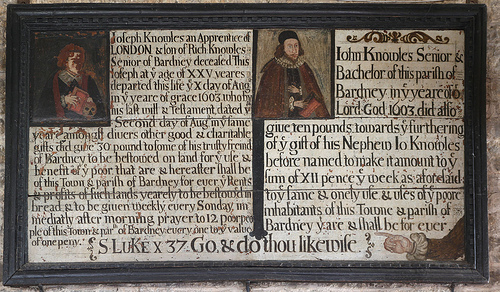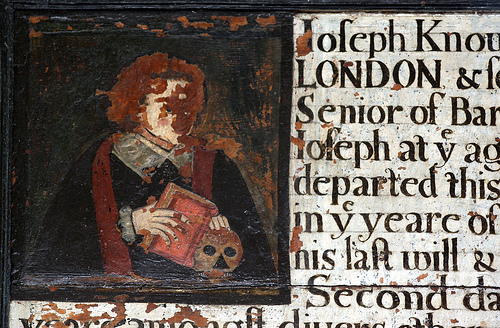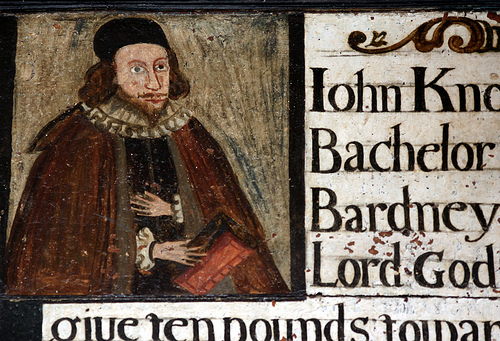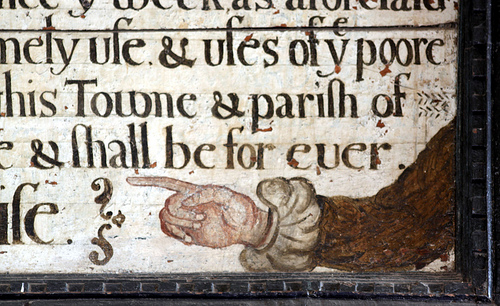Medieval History
This post is entirely off topic, you couldn't you argue that these objects are medieval or medieval revival, but their uniqueness makes them worthy of inclusion. For St Lawrence's in Bardney in Lincolnshire has two remarkable seventeenth century painted charity boards, which commemorate the generosity of parishioners in the alleviation of poverty.

The sixteenth and seventeenth century was a time of great social flux, with the population of England rising. There were winners and losers in this rapid movement and poverty rose considerably. The losers were, of course, as you would expect, the labouring classes. The winners were not the usual suspects, the nobility and gentry, but the 'middling sort', artisans and craftsmen, who with a rise in population found an increased demand for their skills. In this time of boom they invested heavily in property. From this new found affluence and with the memory of their own struggle at the back of their minds, the middling sort developed a strong sense of social responsibility and the charity boards at Bardney reflect that.


The earliest board (above) commemorates the generosity of two members of the same family, both of the middling sort, Joseph Knowles and his uncle John Knowles. Joseph, from Bardney, was an apprentice in London who died in 1603 at the age of twenty five. He had managed to accumulate thirty pounds and this was invested in property to provide an income to buy bread for the poor. When his uncle died, he followed the nephew's example and added an extra ten pounds to the investment, making the weekly disbursement of twelve pence worth of bread. The board bears the portraits of the two benefactors, Joseph has hand placed on a skull, John holding a Bible.

At the bottom a finger points to the exhortation 'Go and do thou likewise', the final command of Christ at the end of the parable of the Good Samaritan (Luke 10. 25-37). A challenge to their neighbours.

Well thirty years later one of their neighbours did likewise. For on the opposite wall of the nave is a similar board. William Hurstcroft, who died in May 1639, gave one of his properties to provide an income to be divided between the poor of Bardney and Newport in Lincoln. Presumably he was in trade in Newport. We are told that this was only one of 'other charitable deeds'. At the top of the panel, like John Knowles clutching in his hand his Bible. The charitable response a consequence of internalising the scriptures.
- Briefly Noted -- Accessus: A Journal Of Premodern Literature And New Media
Readers of Modern Medieval will want to go take a look at the inaugural issue of Accessus, a publication of the Gower Project. This excellent-looking first issue includes the following essays that bring together disability studies, medieval studies, manuscript...
- Author Interviews Coming To Ancient & Medieval Mayhem Blog In June
ROBYN YOUNGInterview with Author, Robyn Young. In early June to kick off the Ancient & Medieval Historical Fiction Group's Medieval Group Read of Insurrection. ...
- My Flesh In Hope Doth Rest
I recently came across these two lovely inscriptions, both in Lincolnshire Churches. The first at Lusby on the Lincolnshire Wolds and the second is at Kettlethorpe close to the border with Nottinghamshire. The Lusby inscription once formed...
- Transitional
Martin church near Horncastle in Lincolnshire, has a fabulous chancel arch. This narrow arch is a text book example of the Transitional style, the moment when Norman architecture gradually gave way to Early English Gothic. ...
- How's This For A Bit Of Atmosphere
A fifteenth century Seven Sacrament font in Ham stone, sandstone recesses with thirteenth and fourteenth century effigies of the Ralegh family, a late medieval waggon roof, a patchwork of old flooring and a late seventeenth century tablet...
Medieval History
Charity Boards
This post is entirely off topic, you couldn't you argue that these objects are medieval or medieval revival, but their uniqueness makes them worthy of inclusion. For St Lawrence's in Bardney in Lincolnshire has two remarkable seventeenth century painted charity boards, which commemorate the generosity of parishioners in the alleviation of poverty.

The sixteenth and seventeenth century was a time of great social flux, with the population of England rising. There were winners and losers in this rapid movement and poverty rose considerably. The losers were, of course, as you would expect, the labouring classes. The winners were not the usual suspects, the nobility and gentry, but the 'middling sort', artisans and craftsmen, who with a rise in population found an increased demand for their skills. In this time of boom they invested heavily in property. From this new found affluence and with the memory of their own struggle at the back of their minds, the middling sort developed a strong sense of social responsibility and the charity boards at Bardney reflect that.


The earliest board (above) commemorates the generosity of two members of the same family, both of the middling sort, Joseph Knowles and his uncle John Knowles. Joseph, from Bardney, was an apprentice in London who died in 1603 at the age of twenty five. He had managed to accumulate thirty pounds and this was invested in property to provide an income to buy bread for the poor. When his uncle died, he followed the nephew's example and added an extra ten pounds to the investment, making the weekly disbursement of twelve pence worth of bread. The board bears the portraits of the two benefactors, Joseph has hand placed on a skull, John holding a Bible.

At the bottom a finger points to the exhortation 'Go and do thou likewise', the final command of Christ at the end of the parable of the Good Samaritan (Luke 10. 25-37). A challenge to their neighbours.

Well thirty years later one of their neighbours did likewise. For on the opposite wall of the nave is a similar board. William Hurstcroft, who died in May 1639, gave one of his properties to provide an income to be divided between the poor of Bardney and Newport in Lincoln. Presumably he was in trade in Newport. We are told that this was only one of 'other charitable deeds'. At the top of the panel, like John Knowles clutching in his hand his Bible. The charitable response a consequence of internalising the scriptures.
- Briefly Noted -- Accessus: A Journal Of Premodern Literature And New Media
Readers of Modern Medieval will want to go take a look at the inaugural issue of Accessus, a publication of the Gower Project. This excellent-looking first issue includes the following essays that bring together disability studies, medieval studies, manuscript...
- Author Interviews Coming To Ancient & Medieval Mayhem Blog In June
ROBYN YOUNGInterview with Author, Robyn Young. In early June to kick off the Ancient & Medieval Historical Fiction Group's Medieval Group Read of Insurrection. ...
- My Flesh In Hope Doth Rest
I recently came across these two lovely inscriptions, both in Lincolnshire Churches. The first at Lusby on the Lincolnshire Wolds and the second is at Kettlethorpe close to the border with Nottinghamshire. The Lusby inscription once formed...
- Transitional
Martin church near Horncastle in Lincolnshire, has a fabulous chancel arch. This narrow arch is a text book example of the Transitional style, the moment when Norman architecture gradually gave way to Early English Gothic. ...
- How's This For A Bit Of Atmosphere
A fifteenth century Seven Sacrament font in Ham stone, sandstone recesses with thirteenth and fourteenth century effigies of the Ralegh family, a late medieval waggon roof, a patchwork of old flooring and a late seventeenth century tablet...
